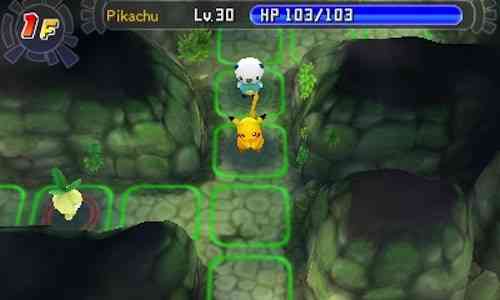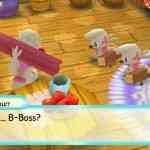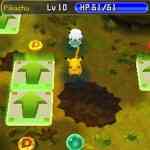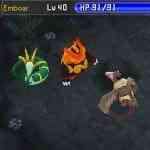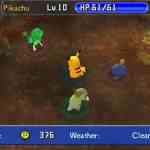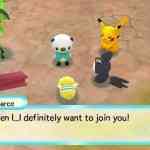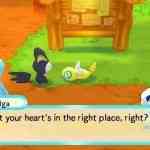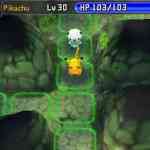Pokémon Mystery Dungeon: Gates to Infinity lets players step into the lives of some of their favourite Pokémon and share in the adventures that these Pokémon embark on. Explore mysterious dungeons, hunt for treasure and items, travel to far off reaches of the land, make new friends and try your hand at urban development as you create your Pokémon Paradise. With this being my first adventure in the world of Pokémon Mystery Dungeons I wasn’t sure what to expect but I was looking forward to the 3D experience.
Pokémon Mystery Dungeon: Gates to Infinity begins with you having just heard a mysterious cry for help from a Pokémon. The next thing you know you awake in the land of Pokémon where you’ve been transformed into one of these cute critters. You can choose your appearance from that of Snivy, Oshawott, Axew, Pikachu, or Tepig and you also get to choose a companion Pokémon from the remaining characters. Fast forward a bit and you reach a point that you are discovered by your companion who has dropped from the sky. After explaining to them what has happened to you, they begin to tell you of their dreams of adventure and proceed to show you the land they have purchased to turn into a Pokémon paradise complete with a home, buildings, shops and an opportunity for adventure in the surrounding Mystery Dungeon. Not knowing why you are there or how to help the Pokémon from your dream you sign on with your new friend to help at least fulfill their dream while hopefully searching for more answers to your true purpose.
Progression in story mode revolves around adventuring and building up the Pokémon Paradise by exploring mystery dungeons, collecting items and/or treasure, and making new friends. The story plays out in a rather linear fashion, as you have to complete specific quests to move forward. In between main quests you can choose to help fellow Pokémon by completing requests found on the Bulletin Board in Paradise. Requests are completed in the dungeons and can range from finding lost items, lost Pokémon to bringing bad Pokémon to justice. There are also challenges on the challenge board that are completed by only the main character. Completing either requests or challenges will result in receiving rewards, items and Paradise points that you can then use to build up Paradise. These requests and challenges provide some flexibility to the game in addition to your building mode. For difficult challenges there is an option to bring a friend along in co-operative play.
One of the quests you will complete will result in you befriending a construction crew of Gurdurr and two Timburrs. Gurdurr will work for you to prepare the land, which is initially in shambles. He will build your requested facilities when you have the necessary money and materials. A list of item requirements can be accessed through the main menu and when choosing requests you can filter them by rewards so you can focus on the requests that will help you get the materials you want. A variety of buildings can be built from dojo’s (move training), fields (growing berries and seeds) as well as some diverse shops. More and more buildings are made available as you continue through the game and as your Paradise rank increases (from collecting Paradise points). Eventually you can even improve the structures or change the colour of the buildings and getting to play around with the buildings and landscape is enjoyable as it gives a needed change of pace to the game.
Gates to Infinity’s gameplay mechanics are a little different than I am used to. To complete the level you have to reach a set of stairs that brings you to the next level or out of the dungeon. The dungeon can either be completed quickly by powering through right to the stairs or using an item which brings you to them, or you can take your time and explore each level fully looking for hidden objects, treasure and enemies to fight. When confronted with an enemy you hold down the L button to access your available moves and press the corresponding button for the move you want to perform. The action is turn based so you have to wait for everyone to make his or her move before you can act again. Where you are standing in the room also makes a difference because if you are not facing your opponent, or if you are not close enough, your attack will not hit the mark. Bag items can be used during a turn; some items can even be thrown at your opponent. If all of your group members are in sync you may also have the ability to use a combined Team Attack which is much more powerful. When this move is available an icon will appear when you hit L, it can be used right away or can be saved for a more challenging battle. Moves can also become stronger if they are trained, the more they are used the higher the level (I, II, III, IV etc.). Characters that have the same moves in the party will be able to use the move at the higher level even if they didn’t train it themselves. After a battle you can recuperate HP by using an item or you have the useful option of hitting A and B together, which will heal you without using an item as long as another enemy doesn’t show up. If your character is defeated during the battle there is a notably cool feature that allows StreetPass to be turned on to see if another person can revive you.
As a member of a HAPPI (Helping Adventuring Pokémon Prosper Institute) recognized team (4 or more Pokémon) you are awarded team badges that you can use to recruit new members. After defeating an enemy in a dungeon they may ask to join your team and you can choose to accept or refuse. Adding new team members gives you more Pokémon varieties to choose from. This can come in handy when travelling in dungeons on days when the V-wave is not favourable to your teams’ types. The V-wave is an ever-present force in the game that gives an advantage to a particular type of Pokémon (e.g. fighting, water, fire, etc.) on a given day. The wind changes daily and you have the opportunity to spin Victini’s V-wheel for a chance to change the wave in your favour. You can spin once a day for free or you can pay coins to add additional winning spots to the wheel for better odds.
As an add-on to your story mode, the game also offers companion play mode where you are able to play as another team member outside of the main story line. In this mode you can do everything your main character can do: build, complete requests and challenges, collect and sell items, etc., but with another character. It gives you an opportunity to try your hand with other Pokémon and their moves and everything that is done in this mode carries over to your main storyline so you can benefit from the gold and items you may collect.
In addition to all this you can also play around with the Discover a Magnagate (an entrance to a dungeon) features. This utilizes the 3DS camera as you try to capture round objects in your own environment. As you scrounge your actual room for circles. When the guide circle turns bright blue and sparkles shoot off you’ve located a hidden magnagate. Once you have located a Magnagate you can play through the dungeon with Servine while Dewotte and Pignite round out your team. The round object you find will determine the difficulty and type. The larger items are harder, and the type will vary by colour. You can replay dungeons you have already located and if you do replay them you have the option of selecting Pikachu, Servine, Dewott or Pignite as your main character. Completing these dungeons will get you some neat items that will also carry over to your story mode.
One of the best things about the visuals in this title was seeing the Pokémon in their 3D representations, much like those from Poképark. During speech sequences the characters are paired with 2D avatar boxes that change to show the Pokémons current emotion (crying, happy, scared, shocked etc.) These emotions might also be portrayed by the use of icons over their heads (question marks, exclamation marks, etc.) though the character themselves remain for the most part unchanged even during cinematic sequences.
As opposed to the traditional Pokémon games that have you following routes and exploring cities, Pokémon Mystery Dungeon has Paradise (your home base), Post Town (location of the shops) and the various Mystery Dungeons to explore. Each is designed creatively in the Pokémon style though now in 3D giving you a sense of depth and allowing you to immerse yourself in the environment much more easily. Each dungeon is broken down into levels that are self-contained with an entrance, an exit, and a finite number of paths. The dungeons are themed towards their location, so you will find an icy cavern dungeon with frost and snow cover and the paths are lined with ice while you will also find a forest dungeon covered in vegetation that has soil and grass paths. When in the dungeon the camera view looks down into the dungeon making it look like a hedge maze where you can’t see over the walls to the other paths. The configuration of each dungeon will change each time you enter it so it provides a considerable amount of replay to the title and allows you to complete multiple requests in that particular dungeon without it feeling overly repetitive. You also get a helpful map view that tracks where you have been, highlights paths, traps, enemies and items as well as shows you what paths remain unexplored.
There were a few graphical issues during gameplay. The first thing, which was the worst, was when I had to try 5-10 times to select the lost Pokémon in the dungeon, after finding them, to complete a request. The Pokémon continually jumped away when I approached it, which seemed counter-productive considering they wanted to be rescued. It was extremely frustrating from a gameplay perspective. This was especially annoying when the character was in a large open space and I had to literally chase them down. The second and third issues are pet peeves of mine, but they are notable. There was no little white box showing the statistics for the Pokémon when they levelled up (you had to scroll through each statistic individually) and after every request was completed the game jumped to the next day. It was probably done this way for storyline purposes since it usually included a night time cut scene about a dream or event, but it had the same exact morning sequence and annoyingly reset you in the house all the time.
Throughout the levels there is instrumental music to be heard that is carefully matched to set the mood for what you are doing (e.g. dungeon exploring or at your house). There are a few sound effects here or there when picking up or interacting with items and more noticeable ones during action moments when in battle, but for the most part the music makes up the majority of the sound components of the game. Sadly, Pokémon Mystery Dungeon: Gates to Infinity does not feature any voice work, just the typing sound of the text as it is printed on the screen. With the title now being in 3D on the 3DS, and seemingly advancing with the technology, voice work would be something on my wish list for a future title. The story line is great and in depth but it translates to a lot of text, for a slower reader this can become time consuming and for me it felt to be a little much.
As with all Pokémon titles there are plenty of play options, hours upon hours of gameplay as well as some downloadable content in the form of additional dungeons you can purchase. From launch through April 30, 2013 you can pick up the Poké Forest dungeon for free.
Even with some positive aspect, one cannot ignore that this game had a small handful of disappointments and annoyances that prevented it from meeting my expectations for the Pokémon series. From the graphical issues, gameplay decisions, to the frequent reminder “You’ve had a great adventure today, why don’t you rest”, these are all things that I could have definitely gone without. At the end of the day ‘Pokéholics’ will enjoy this game, and that is the audience that counts here, but even though I consider myself one, I can’t help but think that this game could have been even more.



